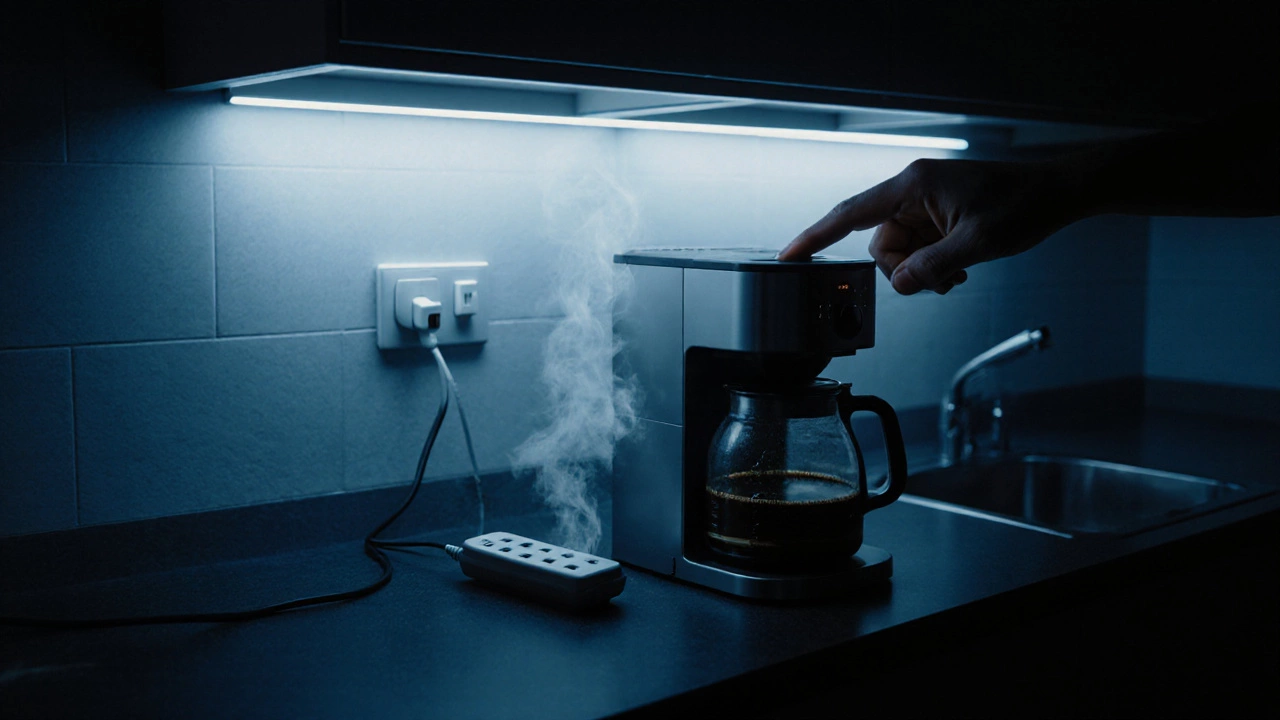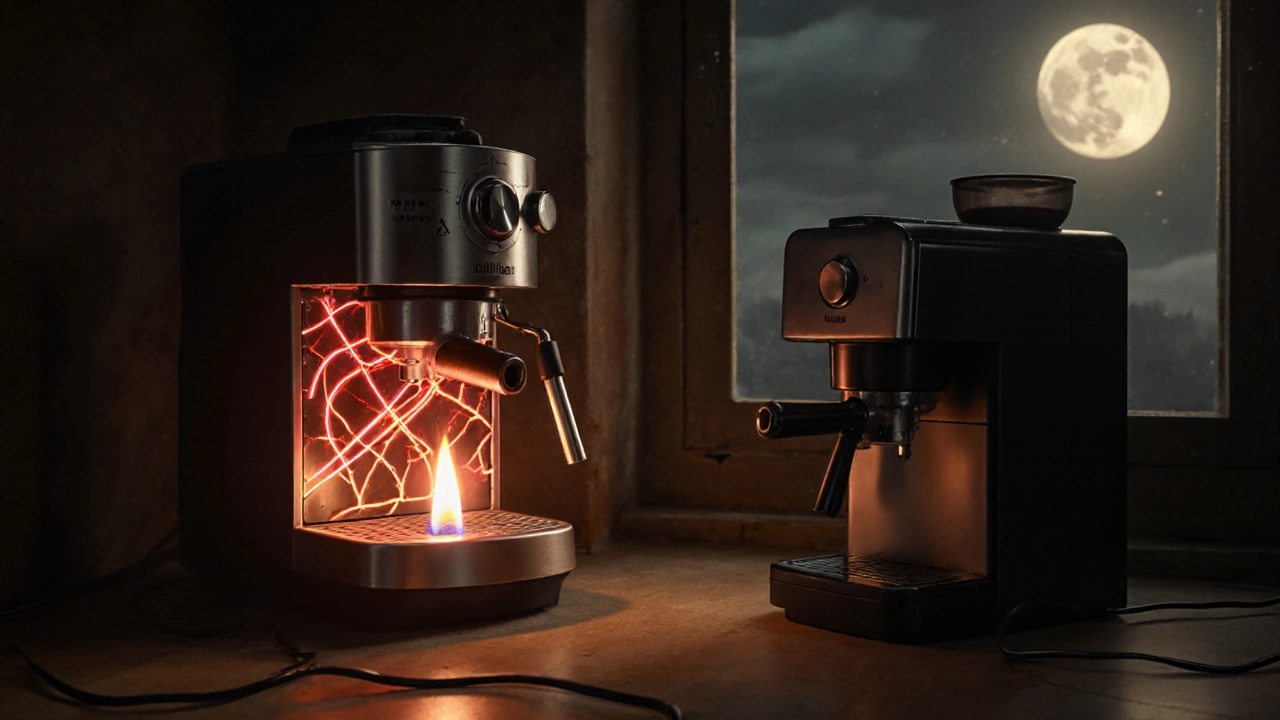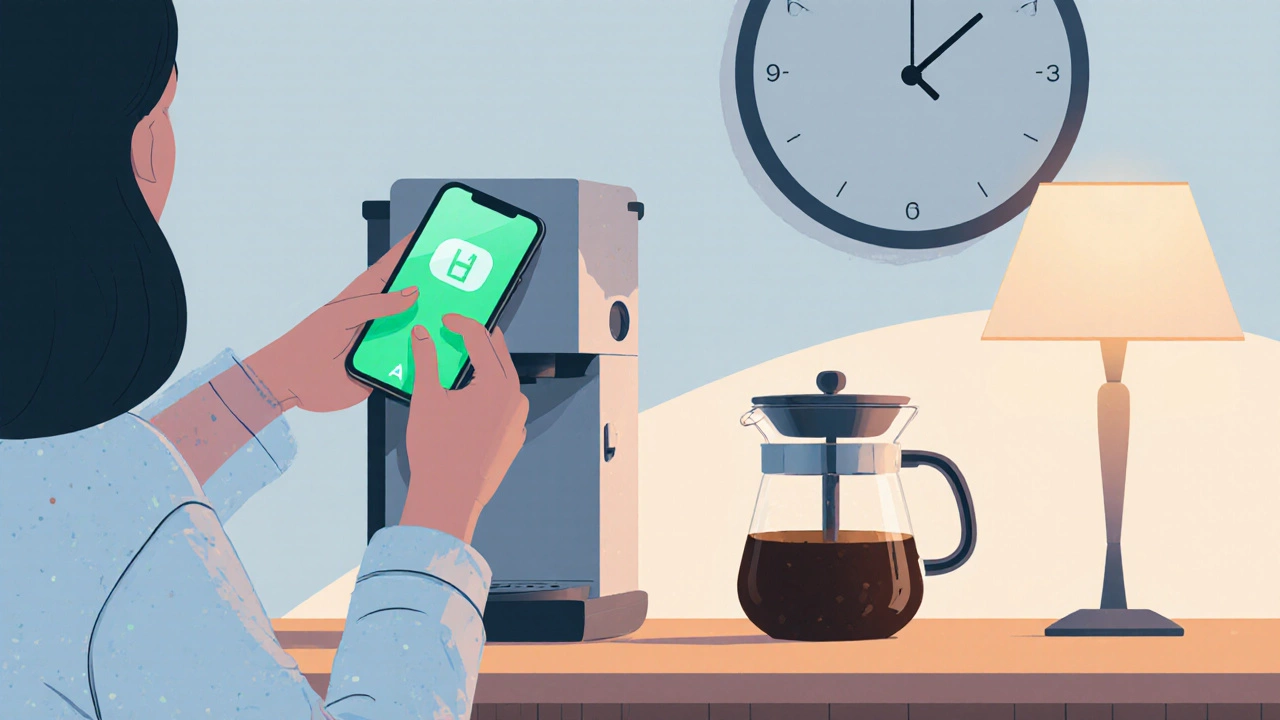
Coffee Machine Energy Cost Calculator
Calculate your energy savings and safety benefits by unplugging your coffee machine overnight. Based on UK energy rates and appliance usage data.
Your Results
Every morning, you press the button and your coffee machine hums to life. But at night, do you leave it plugged in-or flip the switch? It seems like a small choice, but it affects your electricity bill, your machine’s lifespan, and even your home’s safety. Let’s cut through the noise and give you a clear, real-world answer based on how these machines actually work.
Why people leave their coffee machines on
Some folks keep their coffee makers plugged in all the time because they believe it saves time. They think: "Why wait 5 minutes for it to heat up if it’s already warm?" Others say their machine has a built-in timer, so it’s designed to stay on. And then there’s the habit factor-people just never thought to turn it off. But here’s the truth: most coffee machines don’t stay warm enough to brew faster. Even models with "keep warm" plates only maintain surface heat, not internal water temperature. That means when you turn it on in the morning, it still takes 3 to 7 minutes to heat the water to brewing temp. Leaving it on overnight doesn’t speed things up-it just wastes energy.How much electricity does a coffee machine use when left on?
A typical drip coffee maker uses about 800 to 1,200 watts while brewing. But once brewing is done, the "keep warm" function kicks in. That’s where the real drain happens. Even on standby, a coffee machine left on for 12 hours can use between 0.5 and 1.5 kWh per day. That adds up to 15 to 45 kWh per month. According to the U.S. Department of Energy, appliances left on standby can account for 5% to 10% of a household’s total electricity use. For a coffee machine, that’s roughly £3 to £8 extra per year on your UK bill. Sounds small? Multiply that by every appliance you leave on-TV, toaster, kettle-and suddenly you’re talking about £50+ a year just from idle devices.Is it dangerous to leave a coffee machine on overnight?
Yes, there’s a real risk. Coffee machines contain heating elements, water reservoirs, and electrical wiring-all of which can degrade over time. Older models, especially those without auto-shutoff, are more prone to overheating. In 2023, the UK Fire and Rescue Service reported 214 home fires linked to kitchen appliances, with coffee makers among the top 5 causes. Most of these happened because machines were left unattended for hours. Even newer machines with auto-shutoff features aren’t foolproof. If the sensor fails, or if there’s a mineral buildup blocking the water flow, the heating element can overheat. One homeowner in Manchester had a fire start in their coffee maker after it ran dry overnight. The appliance was only two years old. No one was home. The damage cost £8,000.Does turning it off shorten the machine’s life?
No. In fact, the opposite is true. Every time a coffee machine heats up, the metal components expand. When it cools, they contract. That thermal cycling causes stress on solder joints, wiring, and the heating element. But leaving it on 24/7? That’s constant stress. No rest. No cooldown. Manufacturers design coffee machines to handle 10 to 15 cycles per day-not 365 cycles of constant heat. A 2022 study by the European Home Appliance Association found that machines turned off daily lasted an average of 2.3 years longer than those left on. That’s over 40% more lifespan. If you’re worried about wear from frequent on/off switching, consider this: a quality coffee machine is built to handle thousands of power cycles. The real killer is heat, not electricity.
What about smart coffee machines?
Smart coffee makers-like those from De’Longhi, Breville, or Ninja with Wi-Fi and app control-are designed to be energy-efficient. Many have sleep modes that cut power to non-essential parts after 30 minutes of inactivity. Some even learn your routine and only preheat 15 minutes before your usual brew time. But here’s the catch: even smart machines still draw phantom power when plugged in. A 2024 test by Which? found that a smart coffee maker left on standby used 2.7 watts continuously. That’s 23.6 kWh per year-enough to power a LED bulb for 1,000 hours. Turn it off at the socket, and you cut that to zero. If you love the convenience of remote brewing, use the app to schedule your brew, but unplug the machine at night. Or plug it into a smart plug you can turn off with your phone before bed.What’s the best way to turn it off?
Don’t just press the power button. That often only puts it into standby. To truly shut it down:- Press the power button to turn off the machine.
- Unplug it from the wall socket.
- Empty the water reservoir (optional but recommended to prevent mold).
- Wipe the carafe and basket dry.
When should you NOT turn it off?
There are two exceptions:- If you have a thermal carafe model. These machines brew into a vacuum-insulated pot that keeps coffee hot for 4 to 6 hours without electricity. If you’re the only one drinking coffee in the morning, you can brew once and sip all day. No need to reheat.
- If you have a commercial-grade machine. Some espresso machines in small cafes or offices are designed to stay on. They have complex boilers and pressure systems that need constant temperature. But if you’re at home, you almost certainly don’t have one of these.

Real-world tip: The 10-second rule
Here’s a habit that works: before you go to bed, ask yourself: "Did I use this today?" If the answer is no, unplug it. Coffee machine? Unplugged. Toaster? Unplugged. Blender? Unplugged. It takes 10 seconds. You’ll save money, reduce fire risk, and extend your appliances’ lives.What about energy-saving modes?
Many modern coffee makers have an "eco mode" or "energy saver" setting. These usually turn off the warming plate after 2 hours. But that’s still 2 hours of unnecessary heat. If you’re not drinking coffee until 8 a.m., and you go to bed at 11 p.m., you’re wasting 9 hours of power. The only energy-saving mode that matters is the one that cuts all power. That’s the one you control with your hand-or your smart plug.Bottom line: Turn it off. Every night.
Leaving your coffee machine on overnight doesn’t make your coffee better. It doesn’t make your morning faster. It doesn’t protect your appliance. It just burns money, increases fire risk, and shortens the life of your machine. Turning it off is free. It takes seconds. And the benefits stack up: lower bills, fewer fires, longer-lasting equipment. It’s one of the easiest, most effective energy-saving habits you can adopt. If you’ve been leaving it on out of habit, start tonight. Unplug it. See how easy it is. Tomorrow morning, plug it back in, brew your coffee, and feel good knowing you made a smart, safe, and smart choice.Is it safe to leave a coffee machine on overnight?
No, it’s not recommended. Coffee machines have heating elements and electrical components that can overheat, especially if the water runs low or the auto-shutoff fails. In the UK, over 200 home fires each year are linked to kitchen appliances left unattended, including coffee makers. Turning it off at the socket eliminates this risk entirely.
Does turning a coffee machine off and on damage it?
No. Modern coffee machines are built to handle thousands of power cycles. The real damage comes from constant heat, not switching it on and off. Leaving it on 24/7 stresses the internal components more than daily power cycles. Turning it off daily actually extends its lifespan by 40% or more, according to appliance testing labs.
How much money can I save by turning off my coffee machine?
On average, you’ll save £3 to £8 per year by unplugging your coffee machine overnight. That’s based on a typical machine using 0.5 to 1.5 kWh per day in standby mode. While it seems small, if you apply this habit to other appliances-like your toaster, kettle, or TV-you can easily save £50+ annually on your energy bill.
Should I unplug my smart coffee machine at night?
Yes. Even smart coffee machines draw phantom power when plugged in-around 2 to 3 watts continuously. That adds up to over 20 kWh per year. If you want true energy savings, unplug it or use a smart plug you can turn off remotely. You can still use scheduling features during the day, but cut power at night.
What’s the best way to turn off a coffee machine?
Press the power button to turn it off, then unplug it from the wall. Many machines go into standby mode even when powered off, so unplugging is the only way to fully cut power. For convenience, plug it into a power strip with a switch-you can flip it off before bed without bending down.
Do thermal carafes make it okay to leave the machine on?
Yes, but only if you’re using the thermal carafe properly. These carafes keep coffee hot for 4 to 6 hours without electricity. If you brew once in the morning and drink throughout the day, you don’t need to reheat. But if you’re not drinking until the next day, you should still turn the machine off. The carafe doesn’t protect the machine from overheating or energy waste.